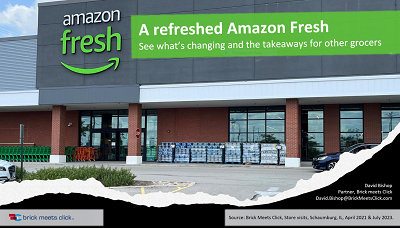Walmart's market share in U.S. eGrocery reaches record high in Q2 2023
Complete the form below to instantly download this month's dashboard.
The market is shifting as consumers adapt to challenging

financial conditions according to Measuring the Online Grocery Market: eGrocery Share in the U.S. , a report released in early September 2023. Flight-to-value behaviors are visible in how households are adjusting the way they buy groceries online. One sign is that Walmart has steadily increased its market share, surpassing the entire Supermarket channel for the past three quarters. Another sign is that Pickup’s share dominance over Delivery continues to grow.
Both shifts have occurred while consumer interest in buying groceries online has waned slightly except for the most engaged users, and while the repeat intent gap between Grocery and Mass has continued to expand.
Supermarkets have lost the top spot to Walmart for three consecutive quarters.
Walmart, which excludes Sam’s Club, surpassed Supermarkets in Q4 2022(following the peak of food-at-home price inflation during Q3), and it hasgradually fortified its top spot as the eGrocery market leader each quarter since then. A year earlier, Supermarkets held a 150-basis point(bps) share edge over Walmart in Q2 2022, however, Walmart finished with a 570-bps share advantage in Q2 of this year.

Households are adjusting to financial pressures as purchasing power has declined.
Although price inflation continues to slow, the impact of much higher prices versus just a couple of years ago, combined with the expiration of COVID financial supports, has fueled this flight-to-value shopping behavior as purchasing power remains under pressure.
BMC POV: It’s vital for grocers to offer customers more ways to save money while also providing the type of experience that online shoppers now expect, as cost considerations will weigh more heavily than convenience for cash-strapped households in the second half of this year.
An independent analysis of CPI data from the Bureau of Labor Statistics, also conducted by Brick Meets Click, documented that the purchasing power of U.S. households dropped over 7% during the first half of 2023 versus a year ago, following a more than 9% decline in the first half of 2022 versus the same period in 2021.
In comparison, just prior to the pandemic purchasing power was far less volatile, slipping just 0.5% and 1% during the first half of 2018 and 2019 respectively.
Demand is shifting to Pickup.
When it comes to how consumers are receiving their online grocery orders, Pickup has continued to capture market share even though Delivery services are more widely available in nearly all U.S. markets today.
In fact, Pickup has steadily expanded its share of eGrocery sales over the last several years compared to Delivery. This is in part because it helps the customer save money compared to Delivery when factoring in the incremental costs associated with higher fees, other charges, and gratuity.
Another reason for the share gains is that Pickup offers several benefits that Delivery can’t, such as the following:
- The flexibility of deciding when to get the order at the store (e.g., you can pick it up later than the scheduled time slot, if needed) versus the waiting time to receive an order at home (i.e., you have a two-hour delivery window which may impact doing and/or delaying other activities).
- The ability to go into the store for other last-minute or high-involvement items, if necessary.
- The assurance of receiving products in better condition, i.e., frozen foods are still frozen.
The net result is that Pickup has continued to grow its slice of the pie. It gained 80 bps during the second quarter of 2022 versus the prior year, and captured another 190 bps in 2023, ending the second quarter with a nearly 48% share of the U.S. market.
What can Supermarkets learn from Target?
From a price perspective, Target is in a similar position to Supermarkets as comparable products clearly cost more than at Walmart. A pricing analysis, conducted by Brick Meets Click earlier this year in the Plano, Texas market that involved both in-store and online audits, found that a basket of 40 commonly purchased products costs 8% more at Target versus Walmart.
Target, however, has some key differences which offer a degree of defense for its online grocery business as well as some lessons for Supermarkets.
- Target’s price gap with Walmart is half that of Supermarket’s price gap with Walmart. And, the 5% discount associated with Target’s RedCard (used in around one-fifth of their transactions according to quarterly financial reports) closes most of that gap.
- In addition, strong and consistent execution has been a big part of Target’s success – especially in fulfilling Pickup orders. It continues to lead most of the industry in extremely short wait times, and this is a large reason why many customers, including time-starved working parents, view Target as a very convenient option.
So, despite its price gap with Walmart, Target has not just held its own in eGrocery but has posted moderate growth over the last two years. It has gained 70 bps of share versus 2021, and finished Q2 2023 with approximately 7% of eGrocery sales.
Consumer interest in buying groceries online declined slightly for all HHs, except the most engaged ones.
The share of U.S. households that completed one or more online orders during Q2 2023 contracted by 275 bps compared to a year ago to just under 53%.
The overall pullback in penetration was due to contractions across all active households except for highest spenders: Those who report doing at least 75% of their grocery spending online expanded by 292 bps versus Q2 2022.
Repeat intent gap between Mass and Grocery continues to widen.
While repeat intent rates during Q2 2023 were down slightly versus last year across Pickup and Delivery and for core formats (Mass, Supermarkets, and Hard Discount), the gap between Mass and Supermarkets for both receiving methods has continued to widen.
The gap in repeat intent that Mass had over Supermarkets for Delivery climbed by 210 bps and Pickup’s grew by 560 bps.
Sponsor’s Message
“As competition for the shopper intensifies, regional grocers should be leveraging analytics and insights to provide customers with personalized recommendations, discounts, and offers as well as developing targeted, cost-effective strategies to encourage and reward repeat purchases online and in-store,” said Sylvain Perrier, president and CEO, Mercatus. “In addition, grocers can expand the online market they serve by offering Pickup as a lower-cost alternative to Delivery.”
NOW AVAILABLE: eGrocery Market Share report

Click here for information about the full report, Measuring the Online Grocery Market: eGrocery Share in the U.S.
About this report and analysis
Measuring the Online Grocery Market: eGrocery Share in the U.S. is a report created by Brick Meets Click and sponsored by Mercatus. The report is designed to help grocery retailers and their suppliers understand the how the eGrocery market is shifting by providing market share estimates across several retail formats (Supermarkets, Mass, Hard Discount, etc.) and receiving methods (Delivery, Pickup, and Ship-to-Home) over a two-and-a-half-year period, running between January 2021 and June 2023.
The analysis leverages data from the monthly Brick Meets Click/Mercatus Grocery Shopping Survey, an independent research initiative created and conducted by Brick Meets Click since March 2020, and sponsored by Mercatus. This analysis is based on 21,799 responses compiled over the 12 months of 2021, 20,948 responses compiled over the 12 months of 2022, and 11,001 responses over the first six months of 2023 from adults 18 years and older who participated in the household’s grocery shopping.











